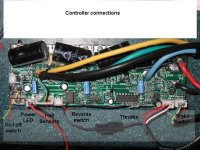i have been replacing the stock 4710 fets with 4110s in 35/40 amp speed controls and it is then possible to double the current limit to 80A with these fets if you use it judiciously. it is important to remember that very high currents can overheat the motor and depolarize the magnets, causing permanent damage.
i would not recommend raising the 40A limit for 4xx crystalytes but gary goodrum seems to be having fun with his 5xx on speed controls i modified with 4110s and modified current sense shunts.
i have been paying $2.50 US for them in 100 pc qty so the price offered seems quite reasonable. i advise anyone who has the mechanical aptitude to do the swap put a set of these fets in your controller if you want to do wheelies and go 40 mph.
i would not recommend raising the 40A limit for 4xx crystalytes but gary goodrum seems to be having fun with his 5xx on speed controls i modified with 4110s and modified current sense shunts.
i have been paying $2.50 US for them in 100 pc qty so the price offered seems quite reasonable. i advise anyone who has the mechanical aptitude to do the swap put a set of these fets in your controller if you want to do wheelies and go 40 mph.


